The ritual of hurling people into space is ingrained in the fabric of Florida's space coast, a 40-mile strip of eastern shoreline that runs from Titusville through Cape Canaveral to Palm Bay in the south.
In 1961, crowds gathered here to see Alan Shepard blast off aboard a Mercury-Redstone rocket and become the first US citizen in space. The Apollo programme to land men on the moon came swiftly after. From here, astronauts flew to the moon, trundled around in buggies, struck a few golf balls and collected lumps of moon rock before heading home.
But this area, which lives in the shadow of the space programme, is facing the end of an era. For the past 30 years, Kennedy Space Centre has been home to the space shuttle, Nasa's great hope for making space travel cheap and commonplace. Tomorrow, one million spectators are expected to gather at vantage points along the coast to witness the launch of Atlantis, the 135th shuttle mission, and the last flight of the fleet. When Atlantis returns in 12 days time it will be dismantled and dispatched to a museum.
The space shuttle fell famously short of expectations. Estimates put the cost of each launch at an exorbitant $1.5bn. Preparation for a mission took months if not years. And flights hardly became routine. Rather than journeying into space once a week – as designers had hoped – Nasa managed only a handful of launches a year.
And then there is the human cost. In 1986, the shuttle Challenger was destroyed on takeoff when a rocket booster exploded, killing its crew of seven. Nasa took great efforts to fix the problem and looked hard at the management failures that led to the accident. Then, in 2003, another shuttle was lost high up in the atmosphere, this time when super-hot plasma tore into the wing of Columbia after it sustained damage from foam falling off the main fuel tank during takeoff. Another seven lives lost. Michael Griffin, the former chief administrator at the US space agency, who bemoaned Nasa's ambitions in space as doing no more than endlessly circling the Earth, called the shuttle "inherently flawed".
The end of the shuttle era brings fresh focus on the shortcomings and mismanagement of the Nasa programme, but amid the criticism, it is worth recalling the achievements too. The shuttle launched and repaired – several times – the Hubble space telescope, which continues to capture spectacular images of the cosmos. The shuttle carried the Chandra x-ray observatory into orbit. And, of course, it was the workhorse behind the $100bn International Space Station, a 500-tonne orbiting outpost as roomy as a five-bedroom house. Thanks to the shuttle, astronauts know how to build spacecraft in space, knowledge that will underpin any future attempt to fly humans to other planets.
For those who flew on the shuttle, it was the experience of a lifetime. No other rocket has carried astronauts into space and flown them back down through the red hot glow of the heated atmosphere to touch down like a glider on a runway. Here, two veterans describe the experience. Scott Altman flew four missions, including two to repair the Hubble telescope. Piers Sellers, from Crowborough, Sussex, flew three shuttle missions, and clocked up nearly five million miles aboard Atlantis last year.
Preparing for takeoff
Scott Altman You wake up around five hours prior to going out to the vehicle. It reminds me of Christmas morning, the level of excitement as you get up and have that last meal, get into your orange launch-and-entry suits in the white room and then get on the bus that takes you out to the pad. There's a background level of anticipation, looking forward to the event. You get out to the pad about three hours prior to the launch. The commander gets in first and is strapped in. The vehicle is on the pad pointed upwards, so everything has been tilted 90 degrees and it is like getting into a different vehicle than the one you trained in. It takes a little effort to get all strapped in, but finally I'm in and the rest of the crew comes in after me. Everything starts to look like the simulators we've spent thousands of hours in. The rhythm feels like the simulators. You forget this is actually launch day and not just another simulation. But as the clock keeps ticking, you go through your checklist, you get down to the point when everything's sealed up and you start thinking this is a little different. Your heart is beating a little quicker.
Piers Sellers A few minutes before launch, the whole shuttle vibrates as it cranks its engines to one side and the other, and backwards. There's a real feeling that the machine is awakening. The seconds go by and everyone is watching. At exactly 10 seconds before launch, all the navigation instruments go from a rest position to active, you can see that navigation is tracking, that it knows where it wants to take the shuttle. A few seconds after that, the main engines light. You can't really feel or hear much at that point. You see the power come up on the indicators in the cockpit, you see the thrust go up from zero to 100% on three engines and then you feel the whole stack sway forwards towards your feet, and that is because the thrust of the engines is so great that it bends the shuttle and stack on its hold-down bolts, and pushes it to one side. They call that the twang. The twang goes all the way, about 4ft, and then the whole stack bounces back. And at exactly the right moment, zero, the solid rocket boosters light and the hold-down bolts explode and off you go. It feels as if someone lit a bomb underneath your back. You just go flying up into the air, like a gigantic hand pushing you up into the sky. You see the launch tower fall by down one side and you are headed upwards into the sky. There's a tremendous feeling of power, there's a lot of vibration, noise, people yelling over the radio, and you get the feeling there's this 2,500-tonne ship going straight up. You are banging around in your seat, while everything is moving around, swaying around in the cockpit, trying to look at the instruments, trying to concentrate, but tremendously excited.
SA The vehicle is shaking incredibly. You can get to switches – you have to take your time and focus on what you're doing and make sure you get to the right switch. As the commander I can see out of my forward window. Mostly you are facing up, so it's nothing but blue sky. On my third mission, though, there was a thin cloud deck and I looked up out of that window and I saw it coming and all of the sudden it was like "whoooosh!" right through it.
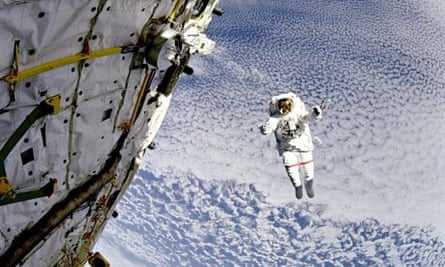
PS After about 45 seconds, you get the call that the main engines are going to throttle down so that the shuttle can ease through the transonic region, and you watch the thrust fall down on the instruments and then you are aware that you are going supersonic about one minute after you launch, but you are going supersonic straight up, not along, straight up, which is kind of incredible. At some point you see the sky go from blue very quickly to black as you punch out of the atmosphere. You keep hammering along like this at first stage for the first two minutes. There's a lot of vibration, a lot of rattling and rolling in the cockpit, until you get to about two minutes and then the solid rocket boosters fall off, each side of the shuttle, and things smooth right out. You have to make an effort to pull the air into your lungs. Expulsion is not a problem at all, your chest just collapses again.
SA At main engine cut-off, all three shuttle engines shut off and "bang!", just like that you're floating. The transition is instantaneous and you feel your body going forwards as if it's a compressed spring and anything that's not tied down goes floating by. You can't see the ground too easily until a point when the whole stack rolls upright and you go from inverted over the Earth to upright, and as you sweep through that roll, you can look out of the window and see the Earth opening up underneath you. I'll never forget that sight on my very first flight when we rolled in the direction and I was looking out of that window. I saw the curvature of the Earth, and the ocean there, the thin blue line at the horizon that is the atmosphere, and it was just an incredible sight. And then it was: "OK, come back in on the dials, let's get back to work."
Floating in orbit
PS We have a plan to get us through the first day in orbit. You get out of your suit, hang it up, then convert the shuttle from being a rocket into being a spacecraft. You're putting out computers, moving bags around, stuff like that, and that takes longer than you'd think, about four or five hours. The next day you catch up with the Space Station and the day after that you dock. And that's exciting. The Space Station goes from being a very distant star when you can first see it to a brighter and brighter light, and then eventually this gigantic silver structure that's hanging there in the black sky above you. You sneak up below it and at the appropriate moment, the shuttle does a pitch around manoeuvre, where in effect it does a loop 600ft below the station, so the guys on the station can photograph the shuttle and see if there's been any damage and send all that digital data back to the ground. You do that and then you come up level with the station and slowly ease yourself in towards it, a bit like a very delicate parking job.
PS The extraordinary thing, particularly when you're spacewalking, is that sometimes it looks like you'd expect it to look, which is you're flying over a huge rotating ball with a black sky and it's breathtakingly beautiful. That's how you'd expect it to be, only better. But sometimes your perceptions can play some tricks on you. Often you feel that the world is like a big wall on one side of you and you are flying horizontally around it. At other times it's like a big ball above you and you're going underneath it. So your orientation changes a little bit but it sinks in that the world is a sphere, and you're going around it, sometimes under it, sideways, or over it. When you look at the world it's incredibly bright. The seas, the oceans, they look like blue neon. It's so bright, it hurts your eyes. You can see everything on the continents, you can see the rivers, the mountains, forests, cities, all sorts of things. You can even see big fields if you look carefully.
SA I joined Nasa just before the 10-year anniversary of the Challenger accident. I really felt that Nasa had done its homework, that we'd learned the lessons from Challenger and that basically it was a management failure: the signs were there but Nasa didn't heed them as well as they could have. Six of the seven astronauts on Columbia [which was destroyed on entry in 2003] were very close friends of mine. Three were my classmates, the other three were in the class right after me. Dave Brown had been my flight surgeon in the navy. It was a shock to me to realise that basically we did almost the same thing again, in that we missed the warning signs: foam falling off the vehicle was a threat and we hadn't learned from that mistake. A long time ago, during the Apollo 1 fire, Frank Borman (a former Apollo commander) said what we had was a failure of imagination, to imagine what could have gone wrong and try to stop it from happening. I think the same thing happened with Columbia.
Returning to Earth
PS To leave, you undock and fly around the Space Station and that's all very slow and balletic and pretty, but not very dramatic. You then spend a day coasting around the Earth, packing things up and getting ready to come home. On entry day you get up early and it's a sprint. You have to pack everything away, secure everything and get in your pressure suit. The whole business really starts at the de-orbit burn. You turn the shuttle so the tail is pointing into the wind, if you like, let rip with the engines for a long burn to kick the shuttle out of orbit, then flip the shuttle over so its nose is pointing the right way for hitting the atmosphere. Very quickly after that you start descending into the upper layers of the atmosphere. You don't see much to start with, but after a while you get this beautiful cherry-red glow all round the shuttle and you can see it snapping over the tail. It kind of pulses, but over the forward cockpit windows it's just a beautiful cherry red that you can see through. In daylight you can see through this red haze and see the world. We actually saw a sunrise come up through the red glow of the entry.
SA From the moment you do your final de-orbit burn, when you're about 12,000 miles from your landing point, one thing you know for certain is that in about an hour the shuttle is going to hit the surface of the Earth. The challenge to you, as commander and pilot, is to make sure where you hit the Earth has a runway underneath it. You really don't have any sense of gravity yet, but as you go through the entry a little bit, you'll go to hang a card on a Velcro spot or something and let go of it and notice it slowly floats to the floor, and you're like, "Wow, look at that!" And you do it again: "Hey, gravity, we haven't seen that in two weeks!" It's amazing. Your perspective has changed. You don't expect things to fall any more and when they start doing so, it's almost like a new experience. You're coming through the atmosphere and if it's night where you are, you look out of the overhead window and you start seeing this little green glow, which is the atmosphere heating up by the friction of the shuttle smashing through it. As you go further and lower, you start to notice it going a little bit darker, into the yellows. On my second entry, I was looking out at that and I started to see it get a little bit darker, so I floated up in my seat a little bit and looked towards the nose and I could see it transitioning from yellow to kind of pink and I floated up a little higher and it was starting to go red, and it was like – "I don't know if I want to look any more" – so I floated back down in my seat because it just looked too hot, too brutal out there.
PS The shuttle does a couple of big S-turns to slow down over the Pacific ocean. In our case, we came zipping across Panama and Cuba and up towards Florida very fast, in just a few minutes. You pop out of the sky at Mach five [3,840mph], and everyone below you hears a double bang as you go transonic. Then you do this great sort of spiral dive over Florida and come down shooting towards the runway, nose pointed almost at the dirt. At the last minute, the commander pulls the nose up and squeaks it on to the runway. You feel the main wheels go down, then the nose wheel, they deploy the chute to slow you down, and then you gradually roll to a stop. At that point there are a lot of smiles. People are happy. Hopefully the mission went well, nobody got hurt, all the tasks got accomplished, and you did it all without disgracing yourself or your friends.
I've flown on two shuttles and they both felt a little bit different. They are real ships with their individual characters and their own nicks and bumps. You look at the shuttle, it's not as if it's this pristine, shining, gleaming piece of metallic technology – it looks like a ship, it's got dents and burns and inside multiple crews have whacked the paintwork and you can see scratches and things. They are ships that have been operated and lived in and done these incredible voyages all with their individual characters. I am personally very fond of the shuttle. When they wind up in museums I'll go and see them and I'll be happy to see them like old friends.
The future of space
PS You will hear that the shuttle cost a lot of money, and it's very complicated and has some embedded risks in its design and all of that is completely true. But if you take the long view, you have to look at what was achieved with the shuttle. You got a beautiful space station, an international space station, a complete 500-tonne orbiting laboratory run by 16 countries that I think is going to deliver some real home runs over the next 10 to 15 years. You got Hubble, not only launched but repaired and serviced four times, Chandra, and a whole lot of other instruments of science. But I think the most important thing that came out of it was we took the business of working and assembling things in space to a high level of artistry. If we go somewhere else, such as Mars, we are going to have to assemble our spaceships in orbit. We know how to do that now. Having put the Space Station together, we know how to do work in orbit, to assemble big structures and complicated pieces of engineering. We've taken a big leap forward in our technology and our operations.
SA Nasa is re-focusing, re-grouping. I think the whole country needs to decide what they want out of a space programme and where we should go. I do think that, in the future, the big things we do in space are going to take the cooperation of the whole world. So the International Space Station is a great partnership to start that effort moving forward to put people on Mars and explore the outer planets and to start extending humanity from our foothold here on Earth into the stars. I am hopeful that the spirit of cooperation will be good not just for efforts in space but for humanity in general, as we learn how to work together. I think we have made a transition into a somewhat unusual place for Nasa, that we're not exactly sure what the next vehicle is, what the next step is. But I think in the end human spaceflight is something that's important to people in general and to humanity as a whole, for looking out and pushing ourselves to ask the next questions and figure out what's out there.
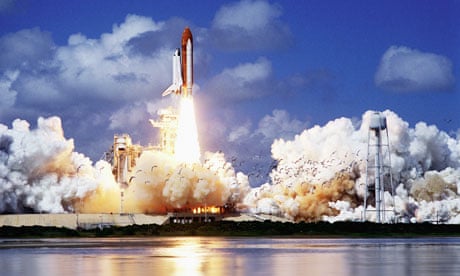
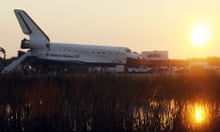
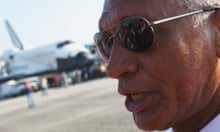
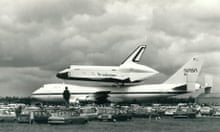




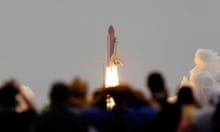
Comments (…)
Sign in or create your Guardian account to join the discussion